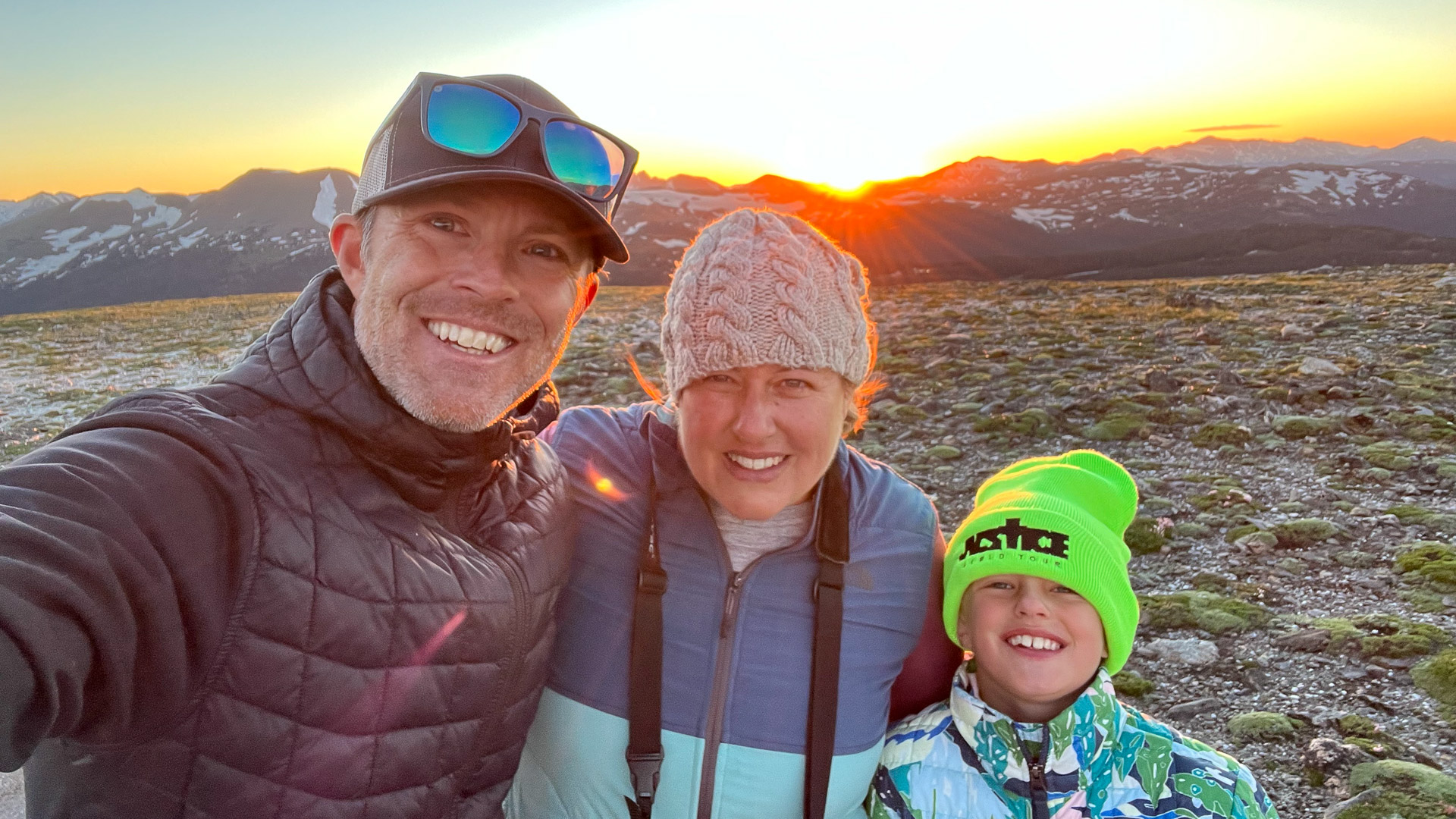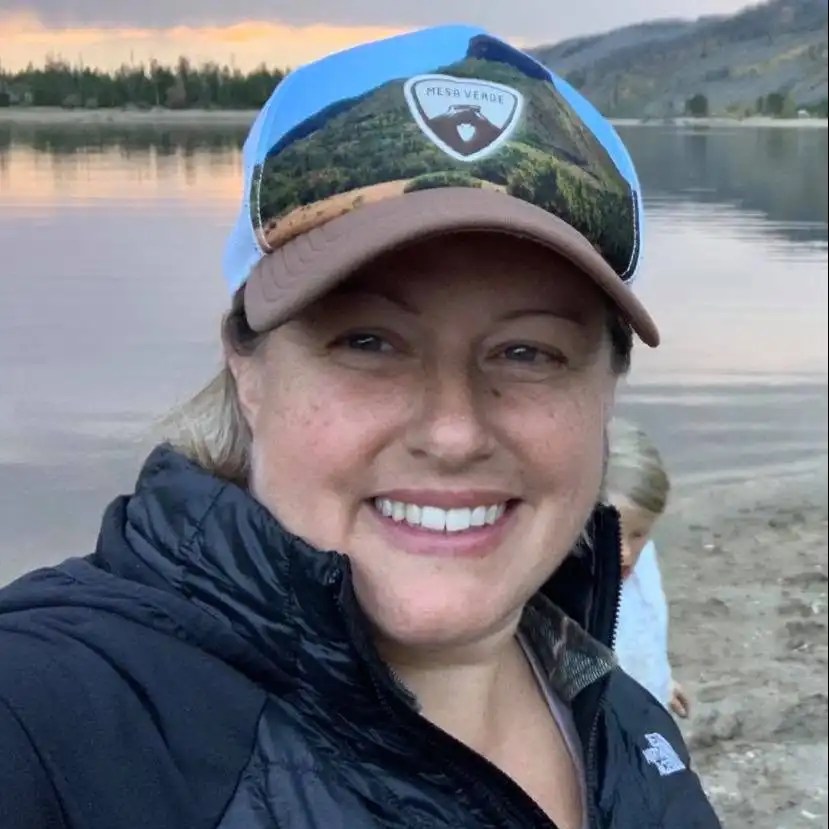
One of our favorite “holidays” of the year is the summer solstice. Some years we have kept our celebration simple, like taking in the sunset at Sunset Beach in North Carolina or doing a sunset picnic on a short trail with Flatirons views close to home.

One thing I have always wanted to do was take in a sunset at Rocky Mountain National Park toward the top of Trail Ridge Road. For those of you not familiar with Trail Ridge Road, it is often referred to as “The Highway to the Sky” and is the highest continuously paved road in the United States. This 48-mile stretch is one of 10 American byways in Colorado with sweeping views of the Rockies in all directions. The road is a bucket-list ride for cyclists. It’s closed for the winter, and when it will open in the spring is up to Mother Nature. The road, which was completed in 1933, takes you from Estes Park through Rocky Mountain National Park to Grand Lake on the opposite side.

There is a short hike on the Alpine Ridge Trail from the parking lot of the Alpine Visitor Center to some of the most incredible views of the Never Summer Mountains and even into Wyoming on clear enough days. This paved, 0.6-mile round-trip hike climbs 209 feet with interpretive signs along the way, taking you to an altitude of 12,005 feet. With no warm-up, it takes your breath away as you climb the paved path and stone stairs.
Rocky Mountain National Park has a reservation system for entrance from late May through October. If you want to enter between 5 a.m. and 6 p.m. for the Bear Lake area, you need a reservation. Trail Ridge Road happens to fall outside of the Bear Lake area, so reservations are only needed between 9 a.m. and 3 p.m.

Sunsets in the park are beautiful throughout the year, not just around the solstice. I have seen some incredible photos of sunsets with snow covering the ground. Although you can get sunset shots at Bear Lake and other locations down that corridor, various places off of Trail Ridge Road are the main spots photographers head to get “the shot.”
With upcoming rain in the forecast and a nice, clear night on the horizon, I wasn’t sure how busy the park would be. It’s the high season for visitation, and it’s the longest day of sunlight for the year, as well. With work and other commitments, we weren’t able to get into the park as early as I wanted to. We arrived through the gates a little past 6:15, giving us about two hours to drive through the park, eat and take in the sunset at 8:36. In the evening, the entrance to the park is often down to one gate open. We have a pass, but the automated pass gate is often not in use.

While I wanted to stop at Sheep Lakes (the best place to view bighorn sheep in the park), because of time we headed straight up Trail Ridge Road after entering the park. It didn’t take long before we pulled over (with a few other cars) to see about eight elk munching in the tall grass. While it is possible to see animals throughout the day in the park, early morning and evening are when the animals are most active.
We stopped to get a few photos before we, and the elk, moved on. Back in the car, we continued up the road past an area called Beaver Ponds and several pullouts in areas known for moose. Unfortunately, we did not see any moose or other animals as we drove up in elevation, but we did see wildflowers in bloom, from paintbrush to avens. We passed by Many Parks Curve, briefly stopped at Hidden Valley to see if we could see any wildlife (no luck) and continued on around Rainbow Curve.

As we climbed higher, the terrain turned to alpine tundra. A third of the terrain in Rocky Mountain National Park is alpine tundra. This biome is very rare to find in the U.S. Lower 48, and many are surprised how many animals in the park actually roam and live in this type of terrain, including elk, pika and bighorn sheep.
There was quite a bit of snow still within the tundra area of the park. Some ski tracks were still visible in the bowl areas. Areas clear of snow showcased some of the wildflowers known throughout the park, including alpine forget-me-nots.

Although it got windier and colder as we went up in elevation, we decided to make a quick stop at the Forest Canyon Overlook. A short 0.3 paved miles takes you to views of Sprague Mountain, Longs Peak, Sundance Mountain and Forest Canyon. As we walked along the path, a man mentioned that there happened to be another tundra animal roaming about. Sure enough, just as we hit the overlook, we could see a few marmots eating the grassy landscape. In fact, one marmot happened to be on the very edge of the paved path. While we were quite startled by it basically being at our feet, it wasn’t alarmed by us at all. This led us to believe that he must have been fed by some visitors in the past.
We took in the overlook, watched the marmots for a bit and then retreated back to the car to warm up. From the Forest Canyon Overlook, we continued up Trail Ridge Road toward the Alpine Visitor Center. Along Iceberg Pass, we saw about 10 elk grazing in the lush, green grass.
We began to chase the sunset as we continued past the visitor center and back down in elevation toward the town of Grand Lake. The sun dipped behind the mountains with our next destination being the Continental Divide and Lake Irene (Milner Pass) at 10,758 feet to see if we could spot any moose known to frequent the area.
As luck would not have it, we didn’t see any moose. I suggested heading all the way down to Beaver Ponds on the Grand Lake side to have a picnic and view wildlife. We were a bit short on time, so we skipped Beaver Ponds this trip and took the road back up to the Alpine Visitor Center.
By now, it was downright chilly with the sun going down and a constant wind. We decided to eat dinner in the back of my Subaru with the trunk open. This offered protection from the wind but allowed us to take in the views of the Never Summer Mountains. The mountains were truly living up to their name, with snow still covering quite a bit of the terrain. Packing tip if you are visiting Rocky Mountain National Park: Bring layers, jackets, gloves and hats. Better to have them and not need them than to not have them at all. The weather turns quickly at 10,000-plus feet.

Charcuterie plate in hand, we enjoyed some meat, cheese and crackers as we talked about our goals for the summer and future summer travel. Bellies pretty full, we had about 15 minutes to climb the pavement and steps to the top of the Alpine Trail at 12,005 feet. My husband decided to carry the plate up to the top so we could enjoy some prosciutto, salami and cheese while taking in the sunset.
Pretty soon the altitude caught up to us, despite living at 5,130 feet. The trail climbs straight up, and we could feel ourselves trying to control our breathing. At least the scenery kept our minds off the struggle.

We made it to the top with time to spare for some photos, a bit of reflection and some mesmerizing views. Another family of three was up at the top shivering in shorts, sweatshirts and sandals. They commented that we came much more prepared, clothing-wise.
Before the sun went completely behind the mountains, the family gave in to the cold and headed back down. All alone on the trail, we sat silently watching the sunset on the longest day of light for the year. I thanked my crew for coming along with me to fulfill a long-wished-for adventure.
We headed back down the trail to the warmth of our car. I threw a few surprise, dirt-ridden snowballs (more like ice chunks) at my husband and daughter before we got to our vehicle. The afterglow of the sunset led us back down Trail Ridge Road. As the last of the light stretched above the mountains, we made our way out of the park. We saw the same 10 or so elk still grazing on Iceberg Pass. As our adventure ended, I made a promise to myself to not wait so long to see another sunset along Trail Ridge Road.

I encourage you to do some research before you head to the park if you want the highest chance of seeing certain animals or catching a full view of the sunset. Even then, you may miss out on seeing the animals you want. That happened to be the case on our trip, although the amazing sunset made up for it. Here are some locations for spotting animals and the sunset along the Trail Ridge Road corridor.
Sunset Viewing Locations Off Trail Ridge Road
- Alpine Ridge Trail Summit (beginning at the Alpine Visitor Center)
- Ute Trail (opposite side of the road from the Alpine Visitor Center)
- Rock Cut
- Forest Canyon Overlook
Best Places To View Wildlife Off Trail Ridge Road
- Beaver Ponds (Estes and Grand Lake sides)
- Forest Canyon Overlook
- Lake Irene
- Alpine Ridge and Ute trails
- Open meadows in the alpine tundra
- Sheep Lakes (take the Fall River Entrance off U.S. Highway 34)





